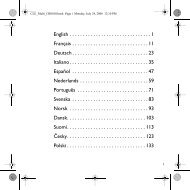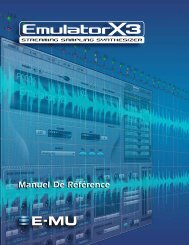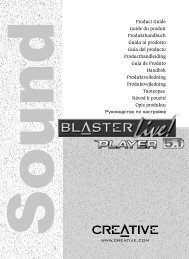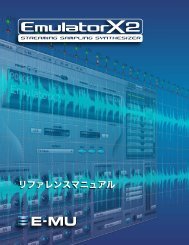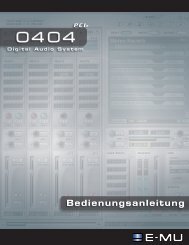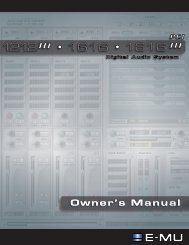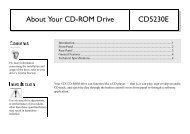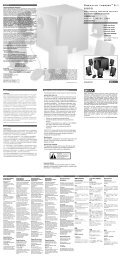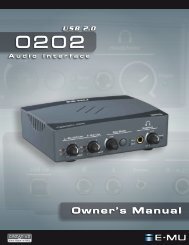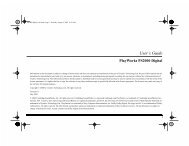You also want an ePaper? Increase the reach of your titles
YUMPU automatically turns print PDFs into web optimized ePapers that Google loves.
5 - Effects<br />
Core Effects Descriptions<br />
Basic Controls<br />
The three main controls of a compressor are the Ratio control, the Threshold control and<br />
the Gain control.<br />
If the signal falls below the Threshold, no processing will take place. Signals exceeding<br />
the Threshold will have gain reduction applied as set by the ratio control. This<br />
important control allows you to dial in the range of amplitudes you want to tame. For<br />
example, if you’re trying to trim off just the loudest peaks, set the threshold so the gain<br />
reduction meter only shows compression during these peaks. One of the biggest<br />
mistakes in using a compressor is having the threshold set too low. This adds noise as<br />
the compressor will always be reducing the volume.<br />
The Ratio control determines how strongly the compressor will affect the signal. The<br />
higher the ratio, the more reduction will be applied. If the ratio is high enough, (above<br />
10:1) the signal will effectively be prevented from getting any louder. In this situation,<br />
the compressor will be acting as a Limiter, placing an upper limit on the signal level. In<br />
general, ratios from 2:1 to 6:1 are considered compression and higher ratios above 10:1<br />
are considered limiting.<br />
The Post Gain control amplifies the signal after it has been compressed to bring it back<br />
up in volume. If you don’t increase the gain, the compressed signal will be much lower<br />
in volume.<br />
Two other important controls are Attack and Release. Attack controls how quickly the<br />
gain is turned down after the signal exceeds the threshold. Release controls how fast the<br />
gain is returned to its normal setting after the signal has fallen below the threshold<br />
again. An attack setting of about 10 milliseconds will delay the onset of compression<br />
long enough to preserve the attack transients in guitar, bass or drums while allowing the<br />
sustain portion of the sound to be compressed. Longer release times are generally used<br />
to reduce the so called “pumping” effect as the compressor turns on and off. Don’t<br />
make the release time too long, however, or the compressor won’t have time to recover<br />
for the next pluck or hit. In general, the attack and release controls are used to smooth<br />
out the action of the compressor, but they can also be used to create special effects.<br />
The Pre-Delay parameter lets the level detector “look into the future” up to 4 milliseconds<br />
in order to anticipate upcoming peaks in the signal. This is accomplished<br />
of course, by inserting delay into the signal path. This lookahead technique<br />
allows the use of slower attack times without missing signal peaks. This<br />
parameter is especially effective on drums and percussion.<br />
The Input Meter allows you to monitor the strength of your input signal. Always try to<br />
boost the signal before the compressor if you can.<br />
The Compression Meter shows the amount of gain reduction being applied. Since this<br />
meter displays how much the gain is being turned down, the meter moves from right to<br />
left, instead of left to right like a normal meter.<br />
Parameter Description<br />
Threshold Threshold sets the input signal level above which dynamic range<br />
compression takes place. Everything above the threshold will be<br />
brought down in volume.<br />
Ratio Sets the ratio of input signal level to output signal level, or “how<br />
much” compression will be applied.<br />
Post Gain Amplifies the signal after it has been compressed to bring up the<br />
volume.<br />
42 <strong>Creative</strong> Professional




